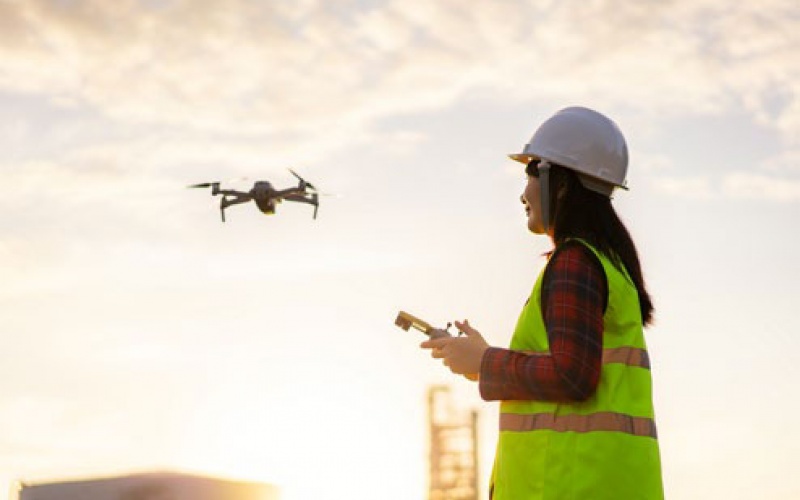
Once confined to the realms of sciencefiction, the use of drones and other modern small aircraft is becoming increasingly feasible as technology becomes more portable, wireless, and smaller. Already we are seeing drones being used for deliveries, as surveillance systems, and as a tool for search and rescue. This subsector of technology is both future-thinking and already providing tangible, practical solutions across industries.
Electric and autonomous flight has the potential to impact every aspect of our lives, presenting a substantial commercial opportunity for those involved. This will span local air-taxis, drone deliveries and autonomous flying vehicles and therefore requires a convergence of multiple technologies including digital twins, 5G, hardware, software, and display technology. These advancements give forward-looking sectors a unique and exceptional opportunity to be at the forefront of some of the UK’s most exciting technological developments.
A sky-high ambition
The revolution in future flight technology is coming. Already we are predicting that by 2030, 25,732 drones will be in use in the agriculture, mining, gas and electricity industries. And this just represents one section of the UK’s economy. At the Future Flight Challenge, we believe the next decade will be the most pivotal for the integration of new flight technologies. Our predictions show that by 2024 services in the real world will be carried out by drones, providing strong socio-economic value positions. By 2026, these services will become commercially viable, bringing investment, and reducing production costs. And by 2030 drones will be fully integrated into our daily lives, providing services, inspection processes, transport, and economic benefits for all. Transitions to new forms of technologies rely on their integration and development in line with the sectors they are set to serve. If we just take the energy sector for instance, we have witnessed monumental change in how automation technologies are used. What has traditionally been viewed as a dirty and polluting industry is quickly becoming one of the most advanced and forward-thinking parts of the modern economy. The advent of renewable energy sources and the potential of AI and robotics have all placed the energy sector at the forefront of modern technological understanding and application. This is because the relationship between the energy sector and cutting-edge technology is mutually beneficial, with energy corporations often investing in novel tech and nurturing it before applications have been developed.
Stronger, better, faster and safer
Drones trump humans in a number of ways, they are lighter, faster, more agile and reduce risk to human life by removing the need to put workers in dangerous situations. The benefits are clear, but relatively speaking drone technology is currently under-deployed in the energy sector. The main potential of future flight technology in this field is in inspection and maintenance; two vital foundations of any asset-owning company. Keeping an eye on the smooth running of a facility and fixing any problem as soon as (or even before) it arises, is crucial to the continual output of energy to the national grid, and the safety of its workers. But in many cases, this is seen as a mammoth task. Oil rigs, gas power-plants, wind and solar farms, and nuclear facilities are some of the most dangerous workplaces on Earth and provide huge logistical challenges for maintenance and inspection.
They also take human workers out of harm’s way. The potential dangers in energy are blatant. Oil rigs are continuously battered by storms, high winds, and rain all while being several miles from the shore. Monitoring parts of the rig that are the most exposed and vulnerable is a necessary task that saves lives in the long-run but can put them at risk in the short-term. But now imagine putting that worker in a safe environment, piloting a drone to the highest and most far-reaching parts of the oil rig, safe from any sudden changes in weather or tide. That is the future that drone technology is realising. And there is clear precedent in the industry. Nuclear energy is carbon-free, immensely powerful and becoming increasingly common, but it is not without risk. Automation and robotics are already at work in areas of high radiation, to increase the safety of facility workers, the same principles of automation and robotics can be applied here too. In 2019 it was estimated that 52% of energy and utility companies have multiple artificial intelligence and automation use cases, this industry has always pioneered the use of novel and cutting-edge tech.
The structural assets involved in energy production are often vast and, with the onset of certain renewable technologies, can be expansive. Solar farms and wind farms can stretch for miles in each direction and are often placed in rural and hard to access areas so as to avoid nuisance to the public. For this reason, keeping an eye on all parts of wind or solar farm at any one time can be a never-ending job, and a complex one too that involves sending workers several dozen feet into the air on a regular basis. A drone provides the solution. A small remote-controlled vehicle, loaded with a live streaming camera is ideal for keeping track of the quality and condition of a field of several hundred wind turbines. A vehicle like this, being able to move at speed, can easily accomplish a task in a fraction of the time that it would have taken a human to do. Imagine how much more impressive this will be with a small ‘swarm’ of drones flying in formation under AI-based autonomous control. This is a use case that the Future Flight Challenge is already supporting. So, whether the assets you are monitoring are tall or expansive, or both, a drone is a clear upgrade from more traditional methods of inspection. Ensuring energy from power plants is safely delivered to homes across the country, via power lines and pipelines stretching hundreds of thousands of kilometres in every direction is also a clear application. With the deployment of a small fleet of drones across a vastly expansive network, you can save time, energy and money scanning up and down cables and pipes for leaks, weather-damage or any other issues that can be prevented before they develop into a problem.
We are all aware of the implications of climate change and the need for new alternatives to achieve our net-zero goal in carbon emissions. Modern drones are green, or at least have the full potential to be entirely renewable. Drones can be either electric or hydrogen powered. Electric drones are fuelled by the grid, and once the grid is entirely renewable, drones will be too. Hydrogen power also offers an attractive solution. Use of hydrogen as a fuel produces only water as a by-product and will also allow drones to travel faster for longer, ideal for longer tasks. One of the many projects already engaged with the Future Flight Challenge includes HyStYRIAA 2.0 (Hydrogen Storage to Energise Robotics in Air Applications 2.0). Their project is exactly the type which we think will form the basis of future hydrogen-powered unmanned flight.
Integration and collaboration are key to a flying future
As drone tech becomes a greater part of our everyday lives in the coming decade, the energy industry must make plans to employ it. Current uptake is lacking, but with the right minds, the right companies and the right innovations, the benefits are there to be reaped. This is why UK Research and Innovation is currently calling on a range of specialists from the energy and technology sector to collaborate in the Future Flight Challenge, to determine how drones are used to survey and manage assets and shape how this new technology is realised in the future.
Integer varius ultricies turpis, vel pulvinar leo lobortis a. In non risus congue, ornare turpis facilisis, vulputate sapien. Fusce fringilla eu eros sit amet dignissim. Phasellus ac ligula massa.

